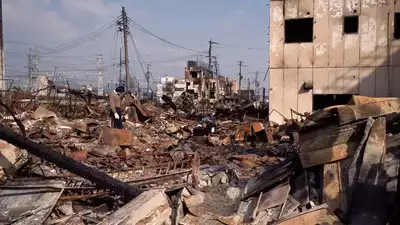Is a Major Great Himalayan Earthquake Imminent? Experts Warn of Seismic Risk

Is a Major Great Himalayan Earthquake Imminent? Experts Warn of Seismic Risk
Introduction
In recent months, scientists and seismologists have been raising fresh concerns about the possibility of a major earthquake striking the Himalayan region. Often referred to as the Great Himalayan Earthquake, this long-anticipated seismic event is considered inevitable by experts due to massive geological stress building up along the fault lines. But is it going to happen soon? How severe could it be? And are we prepared?
Let’s explore what the science says and what actions are being taken.
Why the Himalayan Region Is a High-Risk Earthquake Zone
The Himalayas are one of the most seismically active regions in the world. This is mainly due to the ongoing collision between the Indian Plate and the Eurasian Plate, which has been happening for over 50 million years. The immense pressure from this slow but powerful collision is what created the majestic Himalayan mountain range—and it’s also what makes the region prone to large earthquakes.
Over time, energy builds up in the Earth’s crust. When it’s released suddenly, it results in an earthquake. The longer the build-up, the more energy is stored, and the more devastating the eventual quake can be.
History of Major Earthquakes in the Region
The region has a long history of massive quakes. Here are a few examples:
- 1934 Bihar-Nepal Earthquake: Magnitude 8.0, over 10,000 lives lost.
- 1950 Assam-Tibet Earthquake: Magnitude 8.6, one of the strongest in recorded history.
- 2005 Kashmir Earthquake: Magnitude 7.6, over 86,000 lives lost.
- 2015 Nepal Earthquake: Magnitude 7.8, over 9,000 deaths and widespread destruction.
Despite these, scientists say a massive rupture is still overdue, especially in the central and eastern parts of the Himalayas where strain has been building for centuries.
Recent Warnings from Scientists
Recent research by leading institutions, including the Indian Institute of Technology (IIT) Roorkee, the Wadia Institute of Himalayan Geology, and international seismologists, has emphasized that the region is due for a large-scale earthquake, potentially above magnitude 8.
According to Professor Roger Bilham, a geophysicist at the University of Colorado, “The Himalayan arc is under enormous pressure. A rupture could occur at any time and affect a huge region from Pakistan to Arunachal Pradesh.”
In a 2024 study published in Nature Communications, scientists modeled stress accumulation in the central Himalayas and concluded that the region could release a single, massive earthquake with devastating effects if not broken into smaller ones over time.
What Could Happen If the Earthquake Strikes?
If the Great Himalayan Earthquake does happen, the consequences could be severe:
- Widespread destruction: Cities like Kathmandu, Dehradun, Shimla, and even Delhi could face severe damage.
- Casualties: High population density and weak infrastructure could lead to tens of thousands of deaths.
- Landslides and avalanches: Hilly regions would see major landslides, cutting off entire areas.
- River blockages and floods: Quakes could dam rivers, causing flash floods downstream.
- Communication breakdown: Roads, bridges, and telecom networks could be destroyed, slowing relief efforts.
Is India Prepared?
India has made efforts to improve earthquake preparedness, especially after the 2001 Bhuj earthquake and the 2015 Nepal quake. The National Disaster Management Authority (NDMA) has guidelines for building codes, response protocols, and community awareness.
However, implementation remains inconsistent. Many buildings, especially in smaller towns and cities in northern India, are not earthquake-resistant.
A 2023 government audit found that less than 30% of schools and hospitals in high-risk zones meet the basic safety standards.
The Role of Early Warning Systems
In recent years, early warning systems have shown promise. The Uttarakhand government, in collaboration with IIT Roorkee, launched an Earthquake Early Warning (EEW) system that can provide a few seconds to a minute of advance warning. While that may not sound like much, even a few seconds can help:
- Trains stop
- Elevators halt
- People find shelter
These systems are being expanded across other Himalayan states, but widespread coverage is still a work in progress.
What Can Individuals Do?
While governments play a crucial role, individuals and communities must also be prepared:
- Build earthquake-resistant homes or retrofit existing ones.
- Know safe spots in your home: under sturdy tables, corners away from windows.
- Keep emergency kits with food, water, medicines, flashlights, and important documents.
- Take part in mock drills organized by local disaster response teams.
- Stay informed using government apps and alerts.
For detailed guidelines, the NDMA website has helpful resources:
🔗 https://ndma.gov.in
What Experts Are Saying Now
As of April 2025, there has been no concrete prediction of exactly when the earthquake will happen. Earthquakes are notoriously hard to predict. But experts agree on one thing: the risk is real and growing, and preparation is the best defense.
Dr. Dinesh Tiwari, a senior seismologist at Wadia Institute, says, “It’s not about if, but when. We can’t afford to ignore the science. Preparedness is no longer optional.”
Conclusion
The possibility of a Great Himalayan Earthquake is not just theoretical. It is grounded in science, history, and observable data. While predicting the exact time is impossible, the warnings from scientists are clear and serious. The governments of India, Nepal, Bhutan, and China must work together to improve infrastructure, build resilience, and educate the public.
If you live in or near the Himalayan region, take steps now. Stay alert, stay prepared, and spread awareness. The Earth may shake without warning—but how we respond is in our hands.






